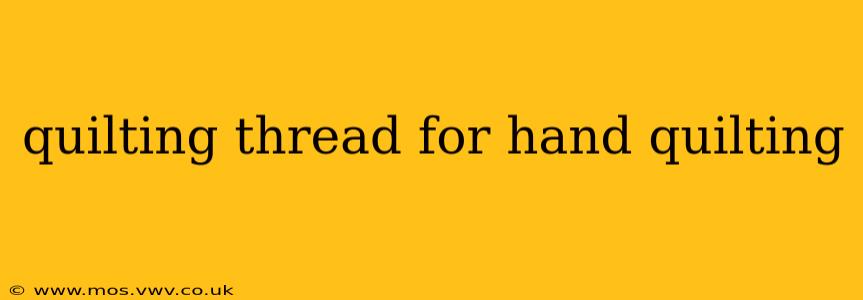Choosing the right quilting thread can significantly impact the look and longevity of your hand-quilted projects. This comprehensive guide will help you navigate the world of quilting threads, ensuring you select the perfect one for your next masterpiece. We'll delve into thread types, weights, and colors, addressing common questions quilters have about this crucial element of the craft.
What Type of Thread is Best for Hand Quilting?
The best thread for hand quilting is generally a 100% cotton quilting thread. Cotton threads are strong, easy to work with, and offer excellent stitch definition. They're also relatively inexpensive and readily available in a vast array of colors. While other materials like polyester exist, cotton's natural fibers are better suited to the demands of hand quilting, offering a smoother quilting experience and preventing breakage.
What Weight Thread Should I Use for Hand Quilting?
The recommended weight for hand quilting is typically 50 wt. (weight). This weight offers a good balance of strength and thinness, making it ideal for creating delicate stitches without being too bulky or difficult to work with. While some quilters prefer a slightly heavier weight for added durability, especially in high-stress areas, 50 wt. remains a popular and versatile choice.
Is All-Purpose Thread Okay for Hand Quilting?
While all-purpose thread can be used in a pinch, it's generally not recommended for hand quilting. All-purpose thread is often thinner and less durable than quilting thread, making it more prone to breakage during the quilting process. This can lead to frustrating delays and potentially damage your finished quilt. Investing in dedicated quilting thread will result in a much smoother and more enjoyable experience.
What are the Differences Between Quilting Thread and All-Purpose Thread?
The key difference lies in the fiber content, twist, and strength. Quilting threads are designed for the specific demands of quilting, featuring a higher twist and stronger fibers that can withstand the stress of multiple stitches and washes. All-purpose thread, on the other hand, is designed for general sewing and lacks the durability required for intricate quilting patterns.
What is the Best Color Thread for Hand Quilting?
The best color of thread depends entirely on your quilt design and personal preference. Many quilters choose a thread that complements the quilt's fabric colors, while others prefer a thread that provides a subtle contrast for increased stitch visibility. Consider the overall aesthetic you want to achieve – a neutral tone will provide a clean, classic look, whereas a contrasting color can add a bold, artistic touch.
How Do I Choose the Right Thread Color for My Quilt?
Start by considering the dominant colors in your quilt. If your quilt has a lot of busy patterns or many different colors, a neutral thread like cream, beige, or gray will tend to make the quilt appear cleaner. If your quilt design is simpler and you want to make the stitching stand out, try a contrasting thread color. Finally, you can always experiment with different thread color options and see what works best!
How Much Thread Do I Need for Hand Quilting?
The amount of thread required depends heavily on the size of your quilt and the density of your quilting stitches. A good rule of thumb is to estimate at least one spool per 500-square inch area of the quilt. This estimate may be on the conservative side; it's always better to have extra thread than to run out in the middle of your quilting.
What Makes a Good Quality Quilting Thread?
A good quality quilting thread will be strong, smooth, and even. It should have a consistent thickness throughout, minimizing breakage and snagging. Look for threads that are long-staple cotton for increased durability and a luxurious feel. A smooth thread will glide easily through the fabric, making the quilting process more efficient.
This guide should provide a solid foundation for choosing the right quilting thread for your hand-quilting projects. Remember to prioritize quality cotton thread for the best results, considering the weight and color to suit your unique design. Happy quilting!
